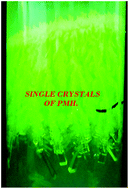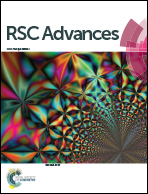Crystallographic, optical and dielectric properties of gel grown praseodymium malonate single crystals†
Abstract
Single crystals of praseodymium malonate hexahydrate are grown by gel encapsulation technique. Single and powder X-ray diffraction data obtained on these crystals is analysed and the internal structure and molecular configuration are determined. The analysis of the crystallographic data shows that the compound crystallises in a monoclinic crystal system with a space group of P2/m. The compound adopts an extended 3-D framework, stabilized by extensive hydrogen bonding. High resolution X-ray diffraction results suggest that the crystals grown are of good quality. The optical characteristics, as obtained from UV-Vis-NIR spectral data, are described. The direct forbidden energy band gap is calculated to be 5.4 eV. Results of photoluminescence, refractive index and birefringence measurements are described and discussed. It is shown that the material has a low dielectric constant and so can be a promising material for microelectronic device applications. The dependence of the dielectric constant, dielectric loss and conductivity on the frequency of the applied ac field is described and discussed. The results are correlated with those of optical and high resolution X-ray diffraction.


 Please wait while we load your content...
Please wait while we load your content...